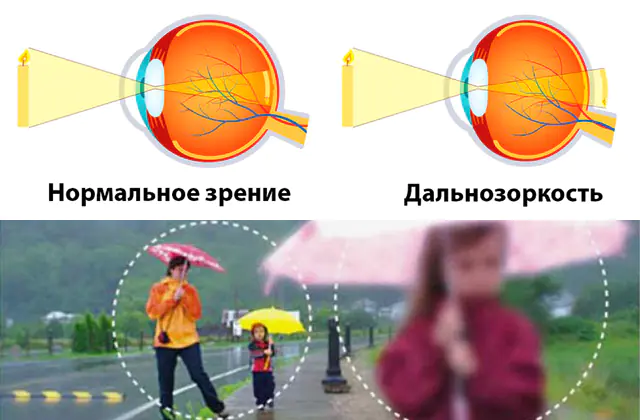
Causes of hypermetropia, symptoms of the disease and its complications. Diagnostic methods, conservative and surgical treatment. Features of glasses and contact lenses for the correction of farsightedness.
The content of the article:- Reasons for appearance
- Main symptoms
- Diagnostic methods
- Treatment options
- Glasses and contact lenses
- Eye exercises
- Medicines
- Surgical intervention
- Prevention
Hypermetropia (farsightedness) is an ophthalmic disease in which light rays reflected from objects are focused outside the retina. That is, a person clearly sees an image in the distance, but has difficulty viewing nearby objects.
- Read a separate article about hypermetropia in children
Causes of hypermetropia in adults
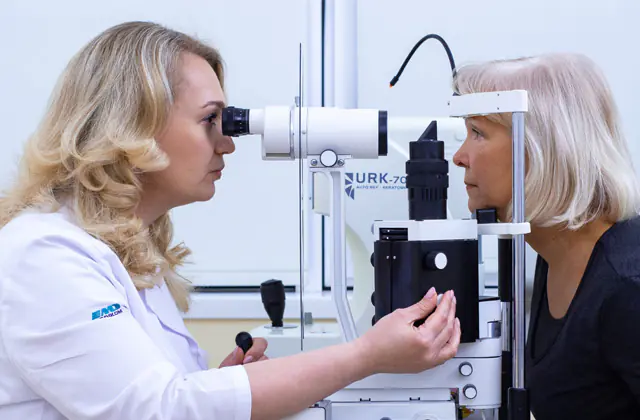
In the photo there is hyperopia in a woman
The human eye is a complex optical system. Like a camera, it can focus on distant and near objects. The lens, ciliary muscle and ligament of Zinn take part in this process. When the functions of these parts of the organ of vision deteriorate, a person suffers from myopia or farsightedness.
The reasons for the development of farsightedness include:
- Genetic predisposition. People with an irregularly shaped eyeball often give birth to children with the same pathology. Parents suffering from eye hypermetropia must register their child in a timely manner and follow all instructions and recommendations of the pediatric ophthalmologist.
- Presbyopia. After 60 years, the lens of the eye loses its ability to accommodate (automatically change focus). Please note that the process of weakening visual function begins after 25 years. Therefore, from your youth, take steps to slow it down.
- Diabetes. High blood sugar causes damage to large and small blood vessels. Because of this, the lens and other parts of the visual organs suffer, farsightedness, myopia, cataracts, glaucoma, and retinopathy appear.
- Appearance of tumors. New growths in the eyeball or in the immediate vicinity of it compress parts of the organ of vision. This leads to poor focusing, insufficient blood supply and other ophthalmic problems.
The main symptoms of hypermetropia in adults
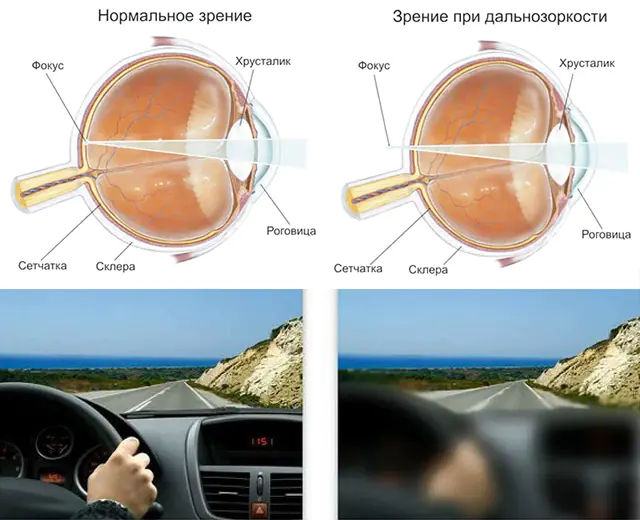
At the early stage of hypermetropia, a person is able to examine objects that are nearby without glasses (reading, writing, working on a computer). But at the same time he notes discomfort, rapid fatigue, a feeling of pain or a foreign object in the eyes.
As the disease progresses, the following signs of hyperthermia appear:
- inability to see objects at a distance of less than 30 cm from the eye;
- headaches in the temples, bridge of the nose, eyebrows;
- sensation of burning, stinging, discomfort, sand in the eyes;
- frequent inflammatory diseases (due to rubbing the eyes with hands);
- poor concentration, decreased performance in adults, deterioration in school performance in children.
The higher the degree of hypermetropia, the more pronounced its symptoms:
- weak - +3.0D lens;
- medium - lens +3.25-5.0D;
- high - lens over +5.0D.
Without timely correction of hypermetropia, the risk of developing complications of the disease increases. These include:
- Strabismus. This is the name of a pathology in which the pupils of the eyes are located asymmetrically. Ophthalmologists explain that when focusing on near objects, the pupils move slightly towards the bridge of the nose. In healthy visual organs, such movements occur automatically. With hypermetropia, the body needs to make efforts, which can lead to malfunctions.
- Spasm of accommodation. In people with good vision, uncontrolled contraction of the ciliary muscle occurs during prolonged concentration on small objects (beads, parts of various mechanisms), as well as when reading, writing, or working at the computer. Patients with severe farsightedness are forced to constantly strain the muscle. Because of this, the likelihood of spasms increases.
- Glaucoma. A common cause of hypermetropia is the flattened shape of the eyeball. This anomaly is also responsible for problems with the outflow of intraocular fluid. Without treatment, throbbing pain and a sharp deterioration in visual acuity appear. Glaucoma is treated conservatively or surgically (depending on the degree of disease progression).
- Blepharitis. With hypermetropia, a person constantly feels tired eyes. He automatically closes his eyes, presses on his eyelids, and rubs them with his fingers. As a result, the likelihood of infection of the mucous membrane increases. The inflammatory process is manifested by redness, swelling, increased lacrimation, and mucous discharge.
In addition to blepharitis, the introduction of dirt leads to the development of barley, conjunctivitis, and chalazion.
If you ignore the symptoms of hypermetropia and its complications, the patient increases the risk of developing partial or complete loss of vision.Methods for diagnosing farsightedness
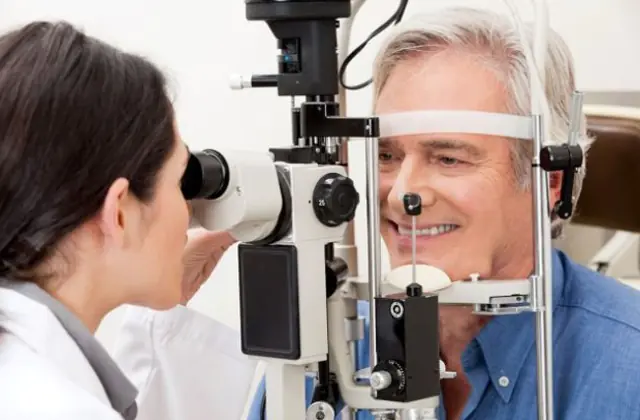
Farsightedness is often detected during an annual preventive examination. To choose the most effective treatment method, the ophthalmologist needs to recognize the type of hypermetropia (congenital, acquired, senile), the degree of its development and concomitant eye diseases.
To do this, the doctor studies the patient’s medical history, asks about the characteristics of his professional activities and leisure activities. After a visual examination of the eyes and determination of visual acuity, the doctor refers the patient to the following diagnostic procedures:
- Autorefractometry. The patient is positioned in front of the device, resting his chin and forehead on its stands. He looks through the slit of the device, focusing his vision on the mark (in the form of an image of an object). At this time, his eye is examined by a computer program. She takes measurements and displays the results on paper in the form of numbers, letters and symbols.
- Skiascopy. At the preliminary stage, the patient's eyes are instilled with a drug that relaxes the ciliary muscle. When the medicine takes effect, the doctor turns off the light and turns on the lamp behind the patient. He directs the beam into the dilated pupil using a siascope (concave mirror). By moving the device around the axis of the handle, the ophthalmologist monitors the characteristics of the movement of the dark spot formed by the shadow.
- Perimetry. The study allows us to identify problems with peripheral vision in hypermetropia. To do this, the patient is positioned in front of the device. He covers one eye with a screen, and the other keeps his eyes on the mark in the center of the field. At this time, the doctor moves the image of the colored dot. As soon as the patient notices it, he immediately tells the specialist about it, naming the color. In this way, the boundaries of a person’s field of vision can be assessed.
- Ultrasonography. The patient sits in a chair and closes his eyes. The doctor applies gel to the eyelids and moves the device’s nozzle over them. At the same time, a black and white image of ultrasonic waves appears on the monitor. By the intensity of the gray color, the ophthalmologist determines the health of the tissues through which they pass. The method is considered absolutely painless and safe.
After evaluating the research results, the doctor tells the patient about the peculiarities of the course of his disease, explains how to treat hyperopia, and how to prevent the development of complications of farsightedness.
Methods for treating farsightedness in adults
There are several treatments for hypermetropia. In childhood, to restore visual acuity, wearing glasses and doing eye exercises are prescribed. After 18 years of age, you can have surgery to correct farsightedness.
Glasses and contact lenses for farsightedness

You cannot choose glasses to correct hypermetropia on your own. In an ophthalmology office, the doctor, using a table and a set of lenses, examines each eye and calculates the distance between the pupils. As a result, the patient can purchase the most convenient and effective accessories with optical action.
Contact lenses for the correction of hypermetropia are not visible to others, do not limit vision, do not break, and do not fog up. Disadvantages include fragility, high price, and the need to strictly adhere to operating and hygiene rules. When selecting this product, the doctor calculates the diameter, curvature, thickness, and wearing period.
Eye exercises for hypermetropia
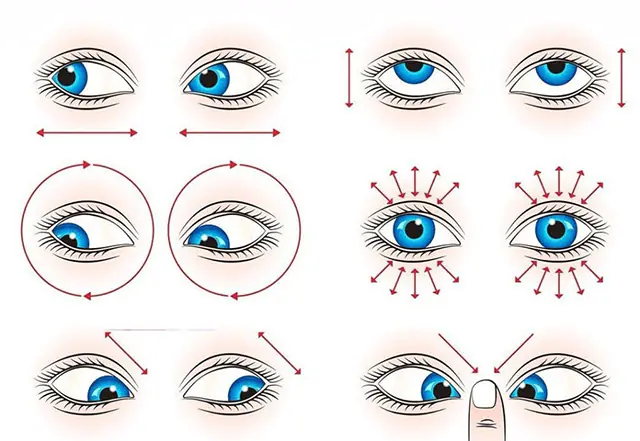
Gymnastics for the eyes helps strengthen the ciliary muscle, activate blood supply, and improve fluid outflow.
Eye exercises for farsightedness:
- Close your eyelids and press them with your palms. Your elbows should rest against the tabletop.
- Alternately look left, up, right, down. Hold your gaze for 2-3 seconds in each position.
- Squint your pupils towards the tip of your nose, hold for 1 second, relax your eye muscles.
- Stretch your hand forward, spread your fingers as far as possible. Look into the gap between them, and then look at the brush.
- Mentally draw geometric shapes, letters, numbers with your eyes closed.
- Massage your eyes and facial skin near the eyelids with your fingers.
While doing eye exercises, take a stable body position and keep your hands clean when massaging your eyelids. Repeat each exercise at least 5 times. The total duration of the warm-up should be 7-10 minutes.
Medications for hypermetropia
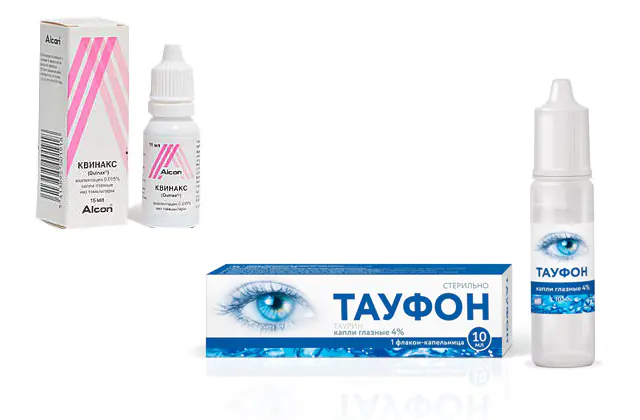
With hypermetropia, the eye muscles are constantly in a tense state. Medicines in the form of drops help relax the ligaments and saturate the eyeball with useful substances.
The most effective remedies for farsightedness include:
- Taufon. The main component of the drops is taurine, a valuable amino acid that is produced in the tear fluid. With age, its synthesis decreases, and the drug helps maintain the necessary concentration of lubricant. Price - from 92 rubles in Russia (50 hryvnia in Ukraine) for 10 ml.
- Reticulin. This analogue of Taufon contains extracts of medicinal plants (terminalia, basil, emblica). It is prescribed for senile farsightedness to eliminate overstrain of the eye muscles. In addition, the drug moisturizes the cornea and nourishes it with vitamins. Price - from 980 rubles in Russia (70 hryvnia in Ukraine) for 10 ml.
Medicines do not contain aggressive chemical compounds and have a gentle effect on the body. The only contraindication is an allergic reaction to the components.
Surgical intervention for farsightedness
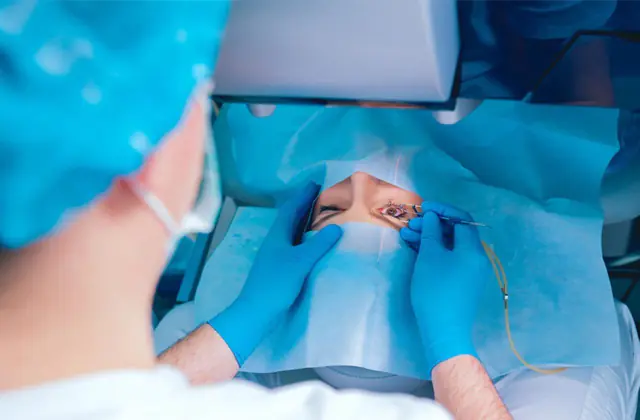
Laser correction is considered the most gentle surgical method for treating hypermetropia. It is prescribed to patients under 40 years of age, with vision deviation up to +3 diopters. The procedure is performed on an outpatient basis using local anesthesia.
Lensectomy is the installation of an artificial lens. This operation to correct hypermetropia is performed under general anesthesia and lasts 20-30 minutes. During this procedure, the surgeon makes an incision in the cornea, clears the eye of the diseased lens, introduces a synthetic analogue, and applies sutures. 2 hours after the end of the procedure, the patient can go home.
Prevention of hypermetropia in adults

To prevent the development of hypermetropia, observe the lighting regime. Make sure that in the dark the overhead light is turned on, a table lamp with a power of 60-100 W. Do not lean over your notebook while writing.
When working with documents, take a break for your eyes every 50-60 minutes. While resting, close your eyes, massage your eyelids, and do exercises for the ciliary muscle. Make sure that there is a sufficient level of humidity in the apartment and office (40-60%).
When diagnosing hypermetropia, do not waste time; begin treatment for the disease as soon as possible. To do this, choose glasses with corrective lenses, use drops to maintain eye health, and take restorative medications.
Don't skip preventive examinations. Treat all diseases of the body in a timely manner. Strengthen your immune system with a healthy diet, giving up bad habits, and hardening procedures.
Video about what farsightedness (hyperopia) is:



